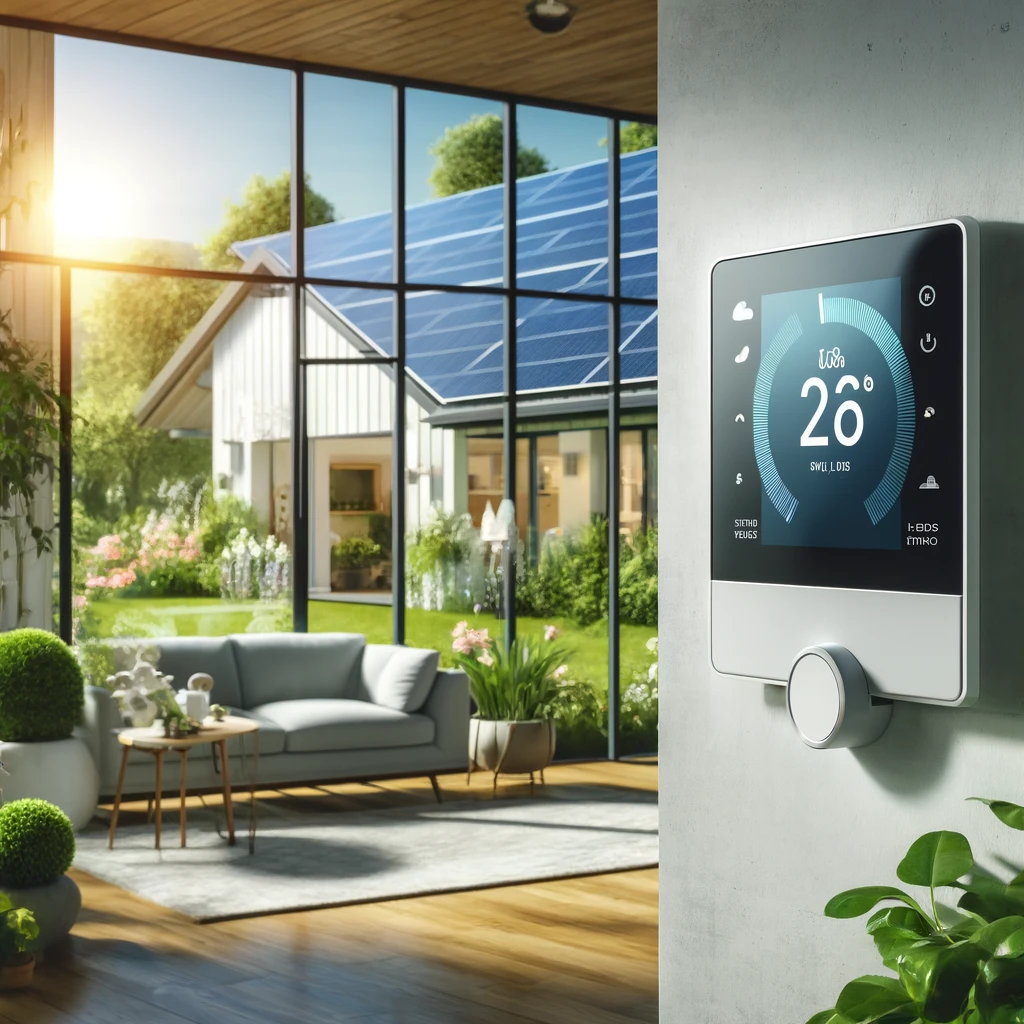Introduction
In the modern quest for energy efficiency and cost savings within our homes, smart thermostats have emerged as a beacon of innovation, offering more than just convenience and control over our living environments. With their ability to learn from our habits, adjust temperatures based on real-time data, and even be controlled remotely, these intelligent devices have seen a surge in popularity among eco-conscious and tech-savvy homeowners alike. This blog post aims to peel back the layers of the smart thermostat’s allure by critically examining whether these devices live up to the hype in terms of providing tangible financial savings. Through an exploration of their functionality, the impact on energy consumption, and real-world savings examples, we’ll uncover if investing in a smart thermostat can truly make a difference in your energy bills, offering a comprehensive guide for anyone considering making the switch to a smarter, more energy-efficient home
What is a Smart Thermostat?
At the core of the evolving smart home ecosystem, smart thermostats stand out for their advanced technology designed to optimize your home’s heating and cooling systems. Unlike traditional thermostats, which require manual adjustments, smart thermostats automate the process, making temperature control not just convenient but also more energy-efficient.
The Basics of Smart Thermostat Technology
Smart thermostats bridge the gap between user convenience and energy efficiency through their innovative use of technology. They connect to the internet, allowing users to adjust their home’s temperature remotely via smartphones or other devices. This connectivity opens up a range of possibilities, from simple remote adjustments to complex algorithms that learn your schedule and preferences, adjusting the temperature automatically to ensure comfort while minimizing energy use. The contrast with traditional thermostats is stark; where once we had to physically dial in our preferred temperature, we can now entrust these intelligent devices to manage our home’s climate based on our habits and the changing seasons, often without any input from us after the initial setup.
Key Features of Smart Thermostats
Delving deeper into what makes smart thermostats a key player in the smart home revolution, several features stand out:
- Remote Control: Perhaps the most immediate benefit is the ability to control your home’s temperature from anywhere. Forgot to adjust the thermostat before leaving on vacation? No problem. A few taps on your smartphone, and your smart thermostat adjusts accordingly.
- Learning Capabilities: Many smart thermostats go beyond simple programmability to actually learn from your behaviors. They can adjust the heating and cooling schedule based on your habits, such as lowering the temperature when the house is typically empty and warming it up as you wake or return home.
- Energy Usage Reports: Beyond just adjusting temperatures, smart thermostats can provide detailed reports on your energy consumption. This insight allows you to see exactly how much energy you’re using for heating and cooling, potentially uncovering opportunities to save even more by tweaking your settings or habits.
These features showcase the transformative potential of smart thermostats, offering a level of interactivity, adaptability, and insight into energy consumption that was previously unimaginable. As we explore their impact on energy savings and whether they’re worth the investment, these technological advancements form the foundation of the smart thermostat’s value proposition to today’s homeowner.
The Financial Impact of Smart Thermostats
The promise of smart thermostats extends beyond convenience and control, touching the core of household finances by potentially reducing energy consumption and, consequently, the monthly energy bills. But how does this promise hold up under scrutiny, and what are the mechanics behind these savings?
Analyzing Energy Consumption
Smart thermostats optimize heating and cooling in several innovative ways. Firstly, their ability to learn and adapt to your schedule ensures that energy is not wasted heating or cooling an empty home. By analyzing your routines, smart thermostats adjust the temperature settings to ensure optimal comfort when the house is occupied and energy savings when it’s not. Additionally, many models use local weather data to make intelligent adjustments. On a mild day, for instance, a smart thermostat might dial back the air conditioning or heating, leveraging the natural temperature to maintain comfort and conserve energy.
Furthermore, geofencing technology in some smart thermostats detects when you and other household members are away from home, switching to energy-saving modes automatically. This dynamic adjustment represents a significant leap from the rigid programming of traditional thermostats, offering nuanced control over energy consumption that can lead to substantial savings.
Case Studies: Real Savings
Real-world applications and studies have provided tangible evidence supporting the efficiency of smart thermostats. For instance, a study by Nest (one of the leading smart thermostat manufacturers) reported an average savings of 10% to 12% on heating and 15% on cooling, amounting to an estimated average annual savings of $131 to $145 for a typical household. Another example involves the Ecobee smart thermostat, which claims an average savings of 23% on heating and cooling costs yearly.
Beyond manufacturer studies, independent research and user testimonials also paint a positive picture. One particularly illustrative case involved a family in a temperate climate zone who switched to a smart thermostat and saw their energy bill decrease by approximately 20% over the course of a year. Such cases, while varied in outcome due to differences in climate, home insulation, and living habits, consistently highlight the potential for smart thermostats to make a dent in energy consumption and, by extension, energy bills.
The savings highlighted in these studies and user experiences underline the smart thermostat’s role not just as a piece of smart home technology but as a tool for financial management and environmental stewardship. By marrying convenience with conservation, smart thermostats present a compelling case for homeowners looking to optimize their energy use and reduce their carbon footprint, all while keeping an eye on their bottom line.
Maximizing Savings with a Smart Thermostat
Achieving the highest level of efficiency and savings from a smart thermostat involves more than just installation; it requires understanding and utilizing its features to the fullest. Here, we dive into strategies to maximize your energy savings without compromising on comfort.
Optimal Settings for Energy Efficiency
Setting your smart thermostat for optimal energy efficiency is a balance between comfort and savings. The U.S. Department of Energy recommends setting your thermostat to 68°F (20°C) during the winter months when you’re awake and lowering it while you’re asleep or away from home. In the summer, the opposite is true; setting your thermostat to 78°F (26°C) when you’re home and higher when you’re away can lead to significant savings. Smart thermostats can automate these adjustments, learning your schedule and preferences to make these changes seamlessly, ensuring you’re not heating or cooling an empty home.
Moreover, many smart thermostats offer “Eco” or “Away” modes, specifically designed to conserve energy. These modes automatically adjust the temperature to a more energy-efficient setting when it detects that no one is home. Utilizing these settings can contribute to noticeable reductions in your energy bills.
Understanding Your Heating and Cooling Patterns
The learning capabilities of smart thermostats are a cornerstone of their ability to save energy. Over time, these devices gather data on your preferences and routines, adjusting their programming to align with your life. For instance, if you consistently turn down the heat at night, the thermostat will start to automate this process. By understanding your heating and cooling patterns, smart thermostats optimize energy use tailored to your specific needs.
Additionally, reviewing the energy consumption reports provided by your smart thermostat can offer insights into your heating and cooling habits, identifying opportunities for further efficiencies. These reports often highlight times of day or specific behaviors that are increasing your energy usage, enabling you to make informed adjustments.
The Role of Smart Home Integration
Integrating your smart thermostat with other smart home devices can unlock additional efficiencies and savings. For example, smart blinds can be programmed to close during the hottest part of the day in summer, reducing the cooling load on your HVAC system. Similarly, smart lights can be set to turn off automatically when the thermostat switches to “Away” mode, further reducing your home’s energy consumption.
Smart thermostats can also work in tandem with smart vents to control the flow of air to different parts of the house, concentrating heating or cooling where it’s needed most and conserving energy in unused areas. This level of integration and automation represents the pinnacle of smart home efficiency, where devices work collaboratively to optimize energy use and enhance comfort, illustrating the true potential of smart thermostats in the broader ecosystem of home automation.
Cost vs. Savings: Is It Worth the Investment?
When considering the shift to a smart thermostat, the decision often boils down to a simple yet crucial question: Do the potential savings justify the initial investment? To answer this, it’s important to delve into the costs involved and the return on investment (ROI) you might expect.
Breaking Down the Initial Costs
The purchase price of smart thermostats can vary significantly, ranging from around $100 to over $250, depending on the brand, model, and features. Installation costs add another layer to consider. While many users choose to install their smart thermostat themselves, leveraging online tutorials and guides provided by manufacturers, others may prefer professional installation, especially if their home’s wiring requires an update. This can add anywhere from $50 to $150 to the overall cost.
Additionally, some homes might require a common wire (C-wire) for the smart thermostat to function properly, which could entail additional electrical work if one is not already present. Thus, the total upfront cost can range significantly based on these variables, potentially reaching up to $400 or more for high-end models with professional installation.
Calculating the Return on Investment (ROI)
Determining the ROI of a smart thermostat involves comparing the upfront costs against the expected savings on energy bills. As discussed earlier, studies and user reports suggest that smart thermostats can save approximately 10% to 23% on heating and cooling bills annually. For a household with an average annual energy cost of $2,200, a savings of up to 20% translates to $440 per year.
To calculate the payback period, divide the total upfront cost by the annual savings. For example, if your smart thermostat and installation cost you $300 and you save $440 per year on your energy bills, your payback period would be less than a year. However, for more expensive setups or homes with lower energy costs, the payback period could extend to two years or more.
It’s also worth considering the non-financial benefits, such as increased comfort, convenience, and the potential for a smarter, more connected home. These benefits, while not directly quantifiable in monetary terms, contribute to the overall value proposition of smart thermostats.
In conclusion, while the initial investment can be significant, the potential for substantial annual savings, along with the added benefits of convenience and comfort, make smart thermostats a worthy consideration for many homeowners. The key to maximizing ROI lies in selecting the right model for your needs, taking advantage of available features, and integrating the thermostat into a broader smart home strategy to enhance efficiency and savings further.
Choosing the Right Smart Thermostat for Your Home
Deciding to invest in a smart thermostat is the first step towards a more energy-efficient home. The next, equally important step is selecting the right device that fits your specific needs and preferences. Here’s what to consider to make an informed choice.
Factors to Consider
- Compatibility with Your HVAC System: Before anything else, ensure the smart thermostat you’re interested in is compatible with your home’s heating and cooling system. Most manufacturers provide compatibility checkers on their websites.
- Ease of Use: Look for a thermostat with an intuitive interface. You should feel comfortable using its basic and advanced features, from setting schedules to adjusting settings via an app.
- Features: Determine which features are most important to you. Do you need geofencing, remote access, energy usage reports, or compatibility with other smart home devices? Prioritize these features during your search.
- Installation: Consider whether you’re comfortable installing the device yourself or if you’d prefer professional installation. Some models are more user-friendly for DIY installation than others.
- Design: Since a smart thermostat will be a visible part of your home, consider its design and display. Some models feature customizable displays or come in various colors to match your home’s aesthetic.
- User Reviews: Finally, take the time to read user reviews. These can provide insight into the reliability of the device, the responsiveness of customer service, and the real-world usability of its app and features.
Recommended Smart Thermostat Models
While it’s essential to conduct your own research tailored to your needs, here are a few models that have garnered positive reviews for their efficiency, user-friendliness, and innovative features:
- Nest Learning Thermostat (3rd Generation): Known for its learning capabilities, this thermostat adapts to your temperature preferences to save energy automatically. It also features a sleek design and a high-resolution display.
- Ecobee SmartThermostat with Voice Control: This model stands out for its integration with Alexa for voice control, remote sensors to manage hot and cold spots in your home, and a touchscreen interface.
- Honeywell Home T9 Smart Thermostat: With remote sensors and geofencing, the T9 adjusts temperatures based on which rooms are occupied. It’s praised for its easy installation and comprehensive app.
- Emerson Sensi Touch Wi-Fi Smart Thermostat: A great value option, the Sensi Touch offers easy installation, a user-friendly app, and compatibility with various smart home platforms.
When choosing a smart thermostat, it’s crucial to balance your budget with the features that will best suit your lifestyle and help achieve your energy-saving goals. Remember, the goal is to enhance comfort, convenience, and savings, so select a model that aligns with these priorities to ensure you’re satisfied with your investment for years to come.
Conclusion
In the realm of smart home technology, smart thermostats have emerged as a significant game-changer, offering not only enhanced control over home heating and cooling but also promising substantial energy savings. From their ability to learn and adapt to household routines, thereby ensuring optimal comfort and efficiency, to their integration within broader smart home systems for a more connected and intuitive living experience, smart thermostats represent a convergence of convenience and conservation. With real-world case studies and energy usage reports consistently showcasing potential savings of up to 26% on heating and cooling bills, the initial investment in a smart thermostat can pay off, both financially and environmentally. The value of these devices extends beyond mere savings, introducing a level of automated home management that prioritizes both the homeowner’s comfort and the planet’s well-being. As we’ve explored the technological intricacies, cost considerations, and energy-saving potentials of smart thermostats, it’s clear that these devices stand as a worthwhile investment for those seeking to modernize their home’s heating and cooling systems while cutting down on energy consumption.



